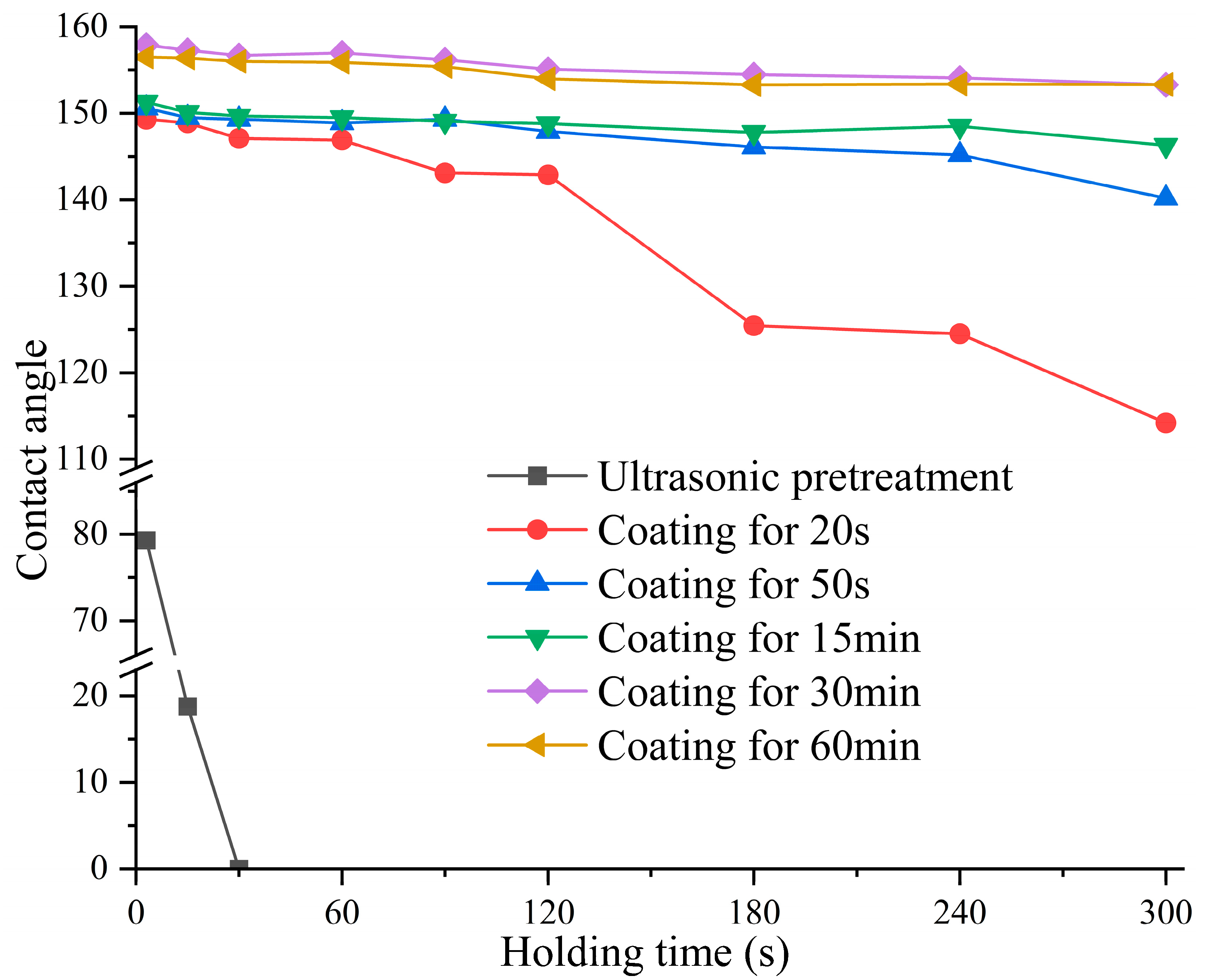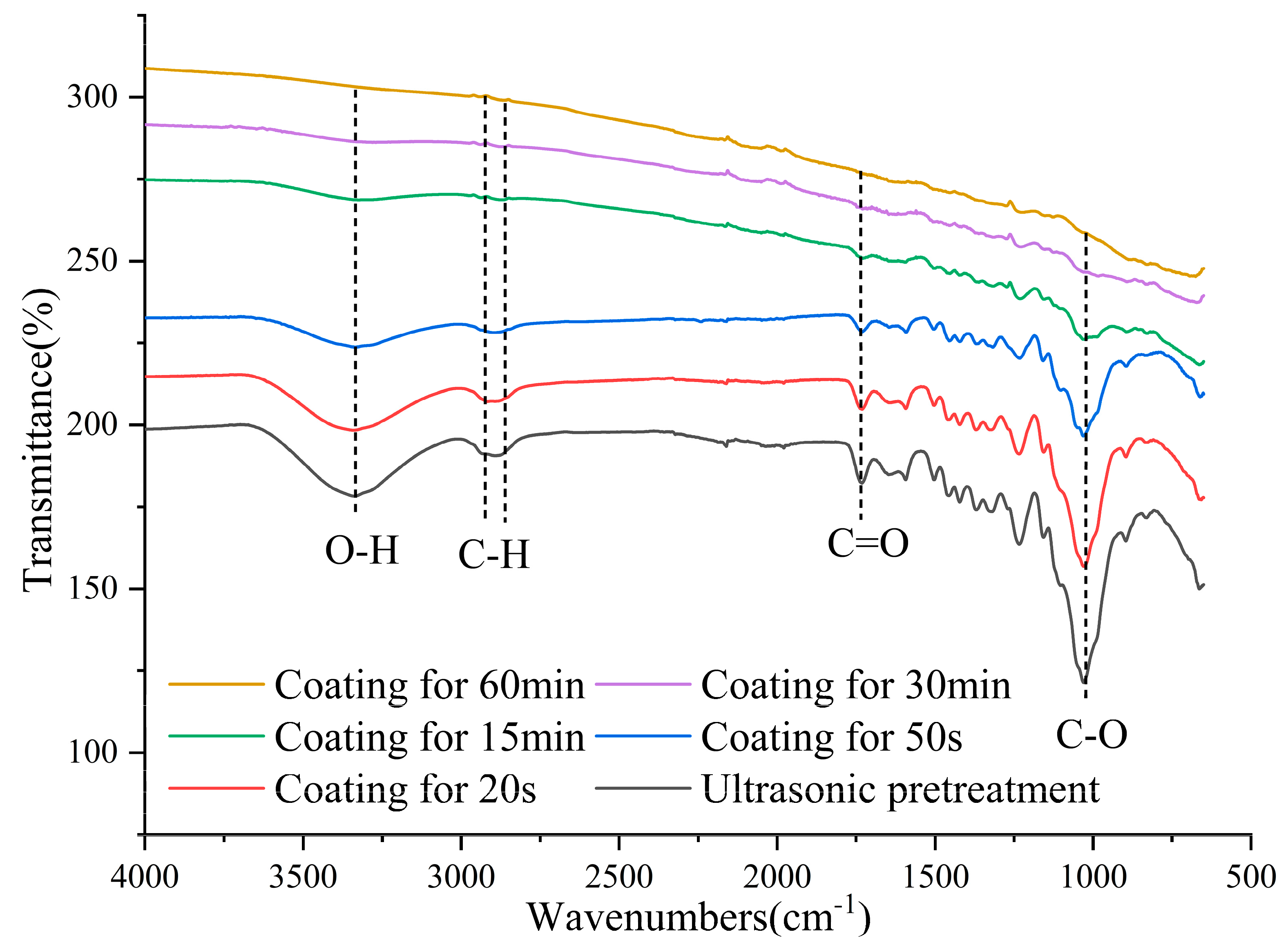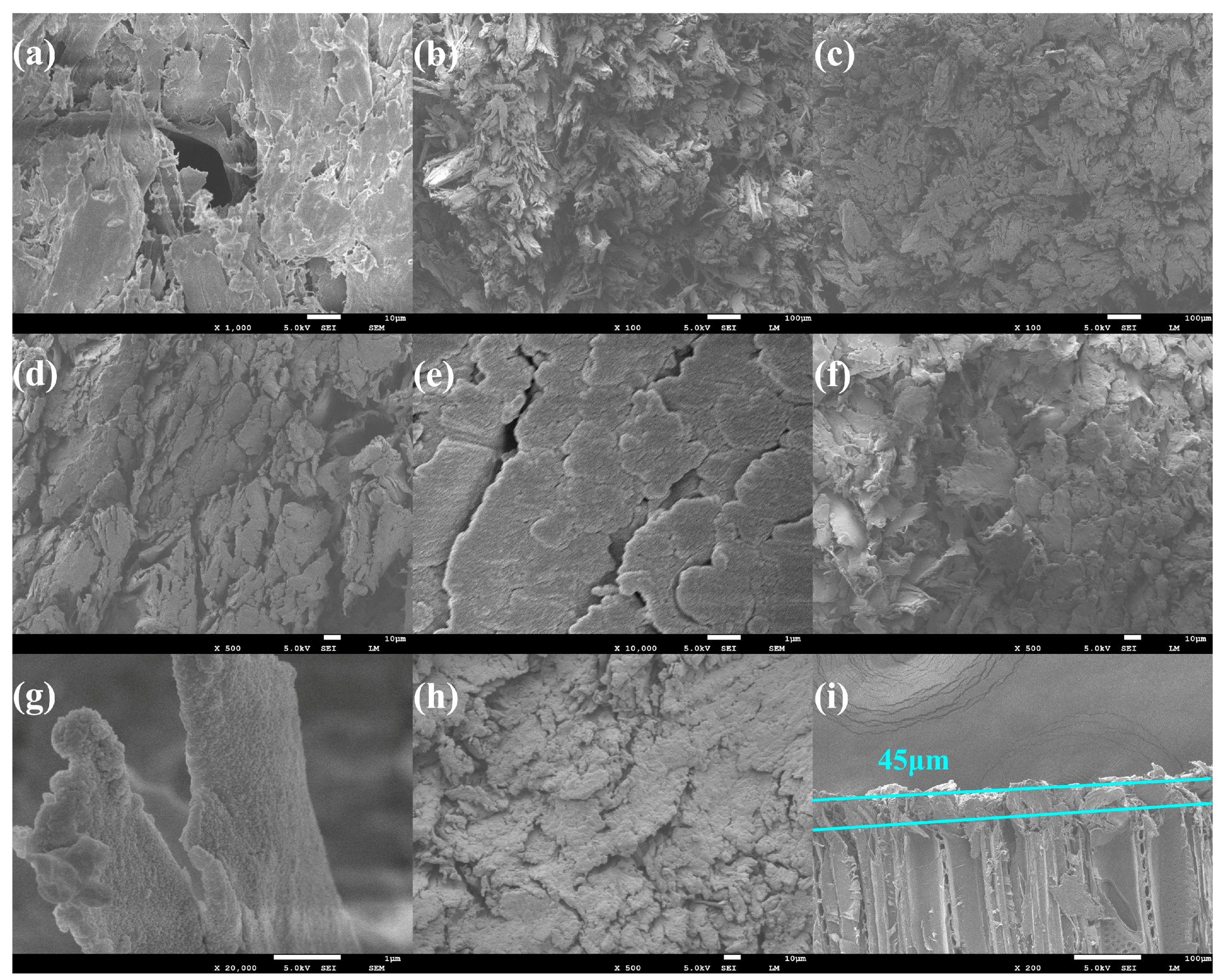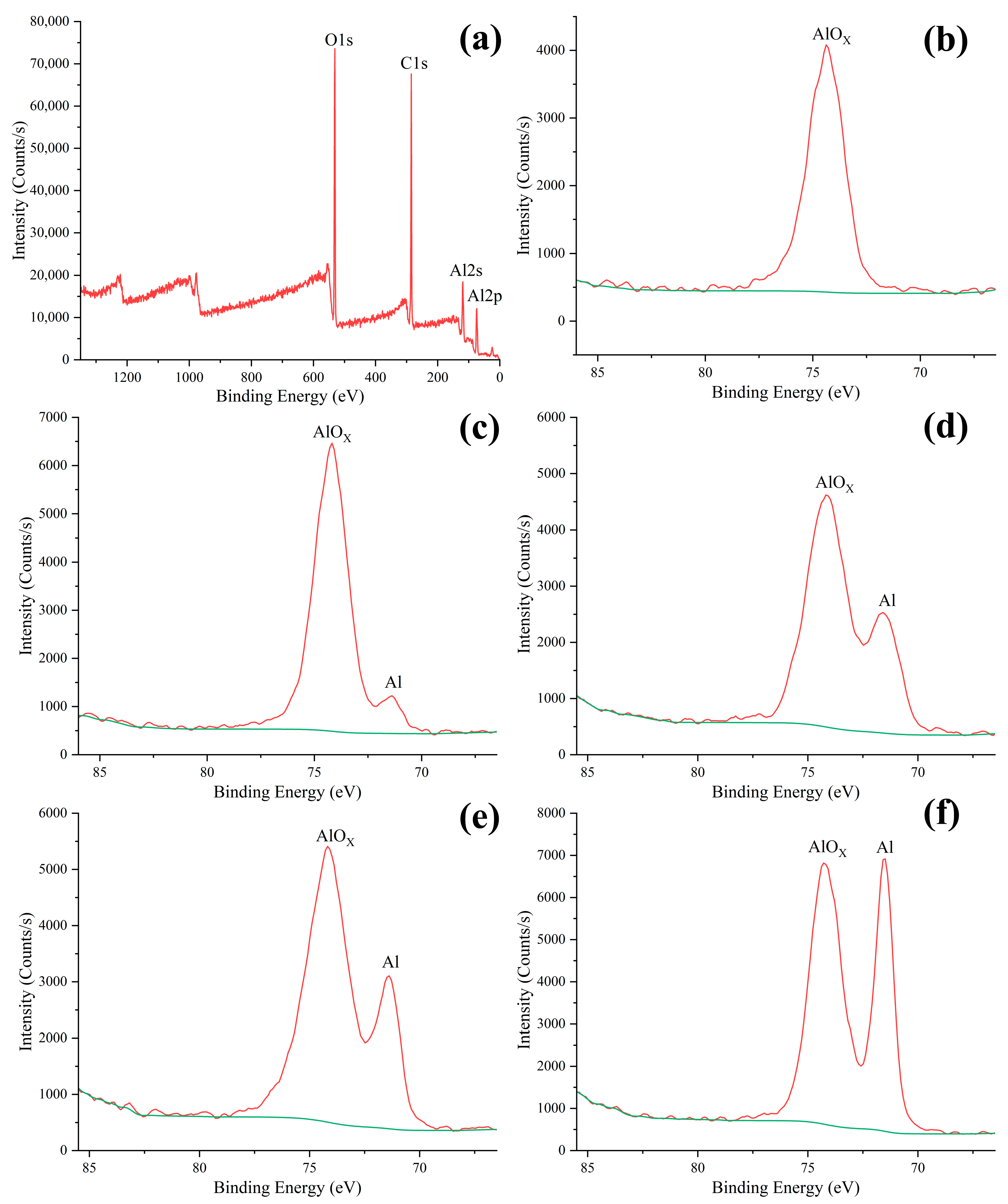Preparation and Superhydrophobicity of Nano-Al-Coated Wood by Magnetron Sputtering Based on Glow-Discharge Plasma
Abstract
:1. Introduction
2. Materials and Methods
2.1. Test Materials
2.2. Ultrasonic Pretreatment
2.3. Preparation of the Al-Coated Wood
2.4. Characterization
2.4.1. Structure
2.4.2. Static and Dynamic Hydrophobic Properties
2.4.3. Fourier Infrared Spectrum
2.4.4. Microscopic Morphology
2.4.5. Surface Fluorescence Effect
2.4.6. Surface Element Content and Distribution
2.4.7. Surface Element Valence
3. Results and Analysis
3.1. Structure Analysis
3.2. Static Hydrophobic Performance Analysis
3.3. Dynamic Wettability Analysis
3.4. Adhesion Analysis
3.5. Infrared Spectrum Analysis
3.6. Microscopic Morphology Analysis
3.7. Surface Fluorescence Effect Analysis
3.8. Surface Element Content and Distribution Analysis
3.9. Surface Element Valence Analysis
4. Conclusions
Author Contributions
Funding
Data Availability Statement
Conflicts of Interest
References
- Song, J.; Chen, C.; Zhu, S.; Zhu, M.; Dai, J.; Ray, U.; Li, Y.; Kuang, Y.; Li, Y.; Quispe, N.; et al. Processing Bulk Natural Wood into a High-Performance Structural Material. Nature 2018, 554, 224–228. [Google Scholar] [CrossRef] [PubMed]
- Tuong, V.M.; Huyen, N.V.; Kien, N.T.; Dien, N.V. Durable Epoxy@ZnO Coating for Improvement of Hydrophobicity and Color Stability of Wood. Polymers 2019, 11, 1388. [Google Scholar] [CrossRef] [PubMed]
- Hooda, A.; Goyat, M.S.; Pandey, J.K.; Kumar, A.; Gupta, R. A Review on Fundamentals, Constraints and Fabrication Techniques of Superhydrophobic Coatings. Prog. Org. Coat. 2020, 142, 105557. [Google Scholar] [CrossRef]
- Fan, X.; Song, S.; Shi, Y.; Cai, M.; Huang, Y.; Zhang, B.; Zhu, M. Mechanochemical Stable Superhydrophobic Coating toward Lasting Corrosion Protection. Prog. Org. Coat. 2023, 178, 107478. [Google Scholar] [CrossRef]
- Boinovich, L.B.; Domantovskii, A.G.; Emelyanenko, A.M.; Miller, A.B.; Potapov, Y.F.; Khodan, A.N. Antiicing Performance of Superhydrophobic Coatings on Aluminum and Stainless Steel. Russ Chem Bull 2013, 62, 380–387. [Google Scholar] [CrossRef]
- Dong, S.; Wang, Z.; An, L.; Li, Y.; Wang, B.; Ji, H.; Wang, H. Facile Fabrication of a Superhydrophobic Surface with Robust Micro-/Nanoscale Hierarchical Structures on Titanium Substrate. Nanomaterials 2020, 10, 1509. [Google Scholar] [CrossRef]
- Yang, S.; Luo, S.; Yang, L.; Yang, X. A Durable Superhydrophobic Surface with Protective Nest-like Micro-Containers. Mater. Today Commun. 2022, 33, 104460. [Google Scholar] [CrossRef]
- Sun, Y.; Wang, Y.; Liang, W.; He, L.; Wang, F.; Zhu, D.; Zhao, H. In Situ Activation of Superhydrophobic Surfaces with Triple Icephobicity at Low Temperatures. ACS Appl. Mater. Interfaces 2022, 14, 49352–49361. [Google Scholar] [CrossRef]
- Dong, J.; Wang, D.; Peng, Y.; Zhang, C.; Lai, F.; He, G.; Ma, P.; Dong, W.; Huang, Y.; Parkin, I.P.; et al. Ultra-Stretchable and Superhydrophobic Textile-Based Bioelectrodes for Robust Self-Cleaning and Personal Health Monitoring. Nano Energy 2022, 97, 107160. [Google Scholar] [CrossRef]
- Zulfiqar, U.; Awais, M.; Hussain, S.Z.; Hussain, I.; Husain, S.W.; Subhani, T. Durable and Self-Healing Superhydrophobic Surfaces for Building Materials. Mater. Lett. 2017, 192, 56–59. [Google Scholar] [CrossRef]
- Luo, J.; Yu, H.; Lu, B.; Wang, D.; Deng, X. Superhydrophobic Biological Fluid-Repellent Surfaces: Mechanisms and Applications. Small Methods 2022, 6, 2201106. [Google Scholar] [CrossRef]
- Haidar, A.; Ali, A.A.; Veziroglu, S.; Fiutowski, J.; Eichler, H.; Mueller, I.; Kiefer, K.; Faupel, F.; Bischoff, M.; Veith, M.; et al. PTFEP-Al2O3 Hybrid Nanowires Reducing Thrombosis and Biofouling. Nanoscale Adv. 2019, 1, 4659–4664. [Google Scholar] [CrossRef] [PubMed]
- Ammarullah, M.I.; Santoso, G.; Sugiharto, S.; Supriyono, T.; Wibowo, D.B.; Kurdi, O.; Tauviqirrahman, M.; Jamari, J. Minimizing Risk of Failure from Ceramic-on-Ceramic Total Hip Prosthesis by Selecting Ceramic Materials Based on Tresca Stress. Sustainability 2022, 14, 13413. [Google Scholar] [CrossRef]
- Xu, L.; Karunakaran, R.G.; Guo, J.; Yang, S. Transparent, Superhydrophobic Surfaces from One-Step Spin Coating of Hydrophobic Nanoparticles. ACS Appl. Mater. Interfaces 2012, 4, 1118–1125. [Google Scholar] [CrossRef] [PubMed]
- Shah, S.M.; Zulfiqar, U.; Hussain, S.Z.; Ahmad, I.; Habib-ur-Rehman; Hussain, I.; Subhani, T. A Durable Superhydrophobic Coating for the Protection of Wood Materials. Mater. Lett. 2017, 203, 17–20. [Google Scholar] [CrossRef]
- Yao, Y.; Gellerich, A.; Zauner, M.; Wang, X.; Zhang, K. Differential Anti-Fungal Effects from Hydrophobic and Superhydrophobic Wood Based on Cellulose and Glycerol Stearoyl Esters. Cellulose 2018, 25, 1329–1338. [Google Scholar] [CrossRef]
- Huang, J.; Wang, S.; Lyu, S.; Fu, F. Preparation of a Robust Cellulose Nanocrystal Superhydrophobic Coating for Self-Cleaning and Oil-Water Separation Only by Spraying. Ind. Crop. Prod. 2018, 122, 438–447. [Google Scholar] [CrossRef]
- Zhao, X.; Park, D.S.; Choi, J.; Park, S.; Soper, S.A.; Murphy, M.C. Robust, Transparent, Superhydrophobic Coatings Using Novel Hydrophobic/Hydrophilic Dual-Sized Silica Particles. J. Colloid Interface Sci. 2020, 574, 347–354. [Google Scholar] [CrossRef]
- Zhan, K.; Lu, Q.; Xia, S.; Guo, C.; Zhao, S.; Gao, W.; Yang, L.; Morrell, J.J.; Yi, T.; Xie, L.; et al. A Cost Effective Strategy to Fabricate STA@PF@Cu2O Hierarchical Structure on Wood Surface: Aimed at Superhydrophobic Modification. Wood Sci. Technol. 2021, 55, 565–583. [Google Scholar] [CrossRef]
- Wang, Z.; Sun, Z.; Chen, X.; Zou, W.; Jiang, X.; Sun, D.; Yu, M. Color Fastness Enhancement of Dyed Wood by Si-Sol@PDMS Based Superhydrophobic Coating. Colloids Surf. A Physicochem. Eng. Asp. 2022, 651, 129701. [Google Scholar] [CrossRef]
- Chen, Y.; Wang, H.; Yao, Q.; Fan, B.; Wang, C.; Xiong, Y.; Jin, C.; Sun, Q. Biomimetic Taro Leaf-like Films Decorated on Wood Surfaces Using Soft Lithography for Superparamagnetic and Superhydrophobic Performance. J. Mater. Sci. 2017, 52, 7428–7438. [Google Scholar] [CrossRef]
- Bao, W.; Liang, D.; Zhang, M.; Jiao, Y.; Wang, L.; Cai, L.; Li, J. Durable, High Conductivity, Superhydrophobicity Bamboo Timber Surface for Nanoimprint Stamps. Prog. Nat. Sci. Mater. Int. 2017, 27, 669–673. [Google Scholar] [CrossRef]
- Yang, Y.; He, H.; Li, Y.; Qiu, J. Using Nanoimprint Lithography to Create Robust, Buoyant, Superhydrophobic PVB/SiO2 Coatings on Wood Surfaces Inspired by Red Roses Petal. Sci. Rep. 2019, 9, 9961. [Google Scholar] [CrossRef] [PubMed]
- Yang, Y.; Shen, H.; Qiu, J. Fabrication of Biomimetic Robust Self-Cleaning Superhydrophobic Wood with Canna-Leaf-like Micro/Nanostructure through Morph-Genetic Method Improved Water-, UV-, and Corrosion Resistance Properties. J. Mol. Struct. 2020, 1219, 128616. [Google Scholar] [CrossRef]
- Makarona, E.; Koutzagioti, C.; Salmas, C.; Ntalos, G.; Skoulikidou, M.-C.; Tsamis, C. Enhancing Wood Resistance to Humidity with Nanostructured ZnO Coatings. Nano-Struct. Nano-Objects 2017, 10, 57–68. [Google Scholar] [CrossRef]
- Lu, Q.; Cheng, R.; Jiang, H.; Xia, S.; Zhan, K.; Yi, T.; Morrell, J.J.; Yang, L.; Wan, H.; Du, G.; et al. Superhydrophobic Wood Fabricated by Epoxy/Cu2(OH)3Cl NPs/Stearic Acid with Performance of Desirable Self-Cleaning, Anti-Mold, Dimensional Stability, Mechanical and Chemical Durability. Colloids Surf. A Physicochem. Eng. Asp. 2022, 647, 129162. [Google Scholar] [CrossRef]
- Tsvetkova, I.N.; Krasil’nikova, L.N.; Khoroshavina, Y.V.; Galushko, A.S.; Yu, V.F.; Kychkin, A.K.; Shilova, O.A. Sol-Gel Preparation of Protective and Decorative Coatings on Wood. J. Sol-Gel Sci. Technol. 2019, 92, 474–483. [Google Scholar] [CrossRef]
- Xia, M.; Yang, T.; Chen, S.; Yuan, G. Fabrication of Superhydrophobic Eucalyptus Wood Surface with Self-Cleaning Performance in Air and Oil Environment and High Durability. Colloid Interface Sci. Commun. 2020, 36, 100264. [Google Scholar] [CrossRef]
- Wang, Y.; Ge-Zhang, S.; Mu, P.; Wang, X.; Li, S.; Qiao, L.; Mu, H. Advances in Sol-Gel-Based Superhydrophobic Coatings for Wood: A Review. Int. J. Mol. Sci. 2023, 24, 9675. [Google Scholar] [CrossRef]
- Wang, Y.; Tang, Z.; Lu, S.; Zhang, M.; Liu, K.; Xiao, H.; Huang, L.; Chen, L.; Wu, H.; Ni, Y. Superhydrophobic Wood Grafted by Poly(2-(Perfluorooctyl)Ethyl Methacrylate) via ATRP with Self-Cleaning, Abrasion Resistance and Anti-Mold Properties. Holzforschung 2020, 74, 799–809. [Google Scholar] [CrossRef]
- Sharma, G.; Kumar, A.; Naushad, M.; Al-Misned, F.A.; El-Serehy, H.A.; Ghfar, A.A.; Rai Sharma, K.; Si, C.; Stadler, F.J. Graft Copolymerization of Acrylonitrile and Ethyl Acrylate onto Pinus Roxburghii Wood Surface Enhanced Physicochemical Properties and Antibacterial Activity. J. Chem. 2020, 2020, e6285354. [Google Scholar] [CrossRef]
- Lu, X.; Hu, Y. Layer-by-Layer Deposition of TiO2 Nanoparticles in the Wood Surface and Its Superhydrophobic Performance. BioResources 2016, 11, 4605–4620. [Google Scholar] [CrossRef]
- Wan, Y.; Hou, S.; Guo, M.; Fu, Y. Surface Properties of Spray-Assisted Layer-By-Layer ElectroStatic Self-Assembly Treated Wooden Take-Off Board. Appl. Sci. Basel 2021, 11, 836. [Google Scholar] [CrossRef]
- Shao, C.; Jiang, M.; Zhang, J.; Zhang, Q.; Han, L.; Wu, Y. Construction of a Superhydrophobic Wood Surface Coating by Layer-by-Layer Assembly: Self-Adhesive Properties of Polydopamine. Appl. Surf. Sci. 2023, 609, 155259. [Google Scholar] [CrossRef]
- Yin, H.; Moghaddam, M.S.; Tuominen, M.; Dėdinaitė, A.; Wålinder, M.; Swerin, A. Wettability Performance and Physicochemical Properties of UV Exposed Superhydrophobized Birch Wood. Appl. Surf. Sci. 2022, 584, 152528. [Google Scholar] [CrossRef]
- Xie, L.; Tang, Z.; Jiang, L.; Breedveld, V.; Hess, D.W. Creation of Superhydrophobic Wood Surfaces by Plasma Etching and Thin-Film Deposition. Surf. Coat. Technol. 2015, 281, 125–132. [Google Scholar] [CrossRef]
- Jnido, G.; Ohms, G.; Vioel, W. One-Step Deposition of Polyester/TiO2 Coatings by Atmospheric Pressure Plasma Jet on Wood Surfaces for UV and Moisture Protection. Coatings 2020, 10, 184. [Google Scholar] [CrossRef]
- Hoshian, S.; Jokinen, V.; Somerkivi, V.; Lokanathan, A.R.; Franssila, S. Robust Superhydrophobic Silicon without a Low Surface-Energy Hydrophobic Coating. ACS Appl. Mater. Interfaces 2015, 7, 941–949. [Google Scholar] [CrossRef]
- Yang, C.; Cui, S.; Weng, Y.; Wu, Z.; Liu, L.; Ma, Z.; Tian, X.; Fu, R.K.Y.; Chu, P.K.; Wu, Z. Scalable Superhydrophobic T-Shape Micro/Nano Structured Inorganic Alumina Coatings. Chem. Eng. J. 2021, 409, 128142. [Google Scholar] [CrossRef]
- Qi, G.; Liu, X.; Li, C.; Wang, C.; Yuan, Z. The Origin of Superhydrophobicity for Intrinsically Hydrophilic Metal Oxides: A Preferential O2 Adsorption Dominated by Oxygen Vacancies. Angew. Chem. Int. Ed. 2019, 58, 17406–17411. [Google Scholar] [CrossRef]
- Sahoo, P.; Dhara, S.; Dash, S.; Raj, B.; Manna, I.; Tyagi, A.K. Air Trapped Nanocavity Induced Superhydrophobicity on GaN Microbelt. Appl. Phys. Lett. 2011, 98, 043103. [Google Scholar] [CrossRef]
- An, X.; Yang, C.; Wu, Z.; Liu, L.; Li, S.; Zhou, L.; Tang, W.; Ma, Z.; Wu, Z.; Fu, R.K.Y.; et al. Self-Regulated Super-Hydrophobic Cu/CuO Electrode Film Deposited by One-Step High-Power Sputtering. Adv. Electron. Mater. 2020, 6, 1900891. [Google Scholar] [CrossRef]
- Bao, W.; Zhang, M.; Jia, Z.; Jiao, Y.; Cai, L.; Liang, D.; Li, J. Cu Thin Films on Wood Surface for Robust Superhydrophobicity by Magnetron Sputtering Treatment with Perfluorocarboxylic Acid. Eur. J. Wood Wood Prod. 2019, 77, 115–123. [Google Scholar] [CrossRef]
- Li, G.; Wang, B.; Liu, Y.; Tan, T.; Song, X.; Li, E.; Yan, H. Stable Superhydrophobic Surface: Fabrication of Interstitial Cottonlike Structure of Copper Nanocrystals by Magnetron Sputtering. Sci. Technol. Adv. Mater. 2008, 9, 025006. [Google Scholar] [CrossRef]
- Gupta, N.; Sasikala, S.; Mahadik, D.B.; Rao, A.V.; Barshilia, H.C. Dual-Scale Rough Multifunctional Superhydrophobic ITO Coatings Prepared by Air Annealing of Sputtered Indium-Tin Alloy Thin Films. Appl. Surf. Sci. 2012, 258, 9723–9731. [Google Scholar] [CrossRef]
- Abid, N.; Khan, M.; Shujait, S.; Chaudhary, K.; Ikram, M.; Imran, M.; Haider, J.; Khan, M.; Khan, Q.; Maqbool, M. Synthesis of Nanomaterials Using Various Top-down and Bottom-up Approaches, Influencing Factors, Advantages, and Disadvantages: A Review. Adv. Colloid Interface Sci. 2022, 300, 102597. [Google Scholar] [CrossRef]
- Sarakinos, K.; Alami, J.; Konstantinidis, S. High Power Pulsed Magnetron Sputtering: A Review on Scientific and Engineering State of the Art. Surf. Coat. Technol. 2010, 204, 1661–1684. [Google Scholar] [CrossRef]
- Wan, C.; Jiao, Y.; Li, J. A Cellulose Fibers-Supported Hierarchical Forest-like Cuprous Oxide/Copper Array Architecture as a Flexible and Free-Standing Electrode for Symmetric Supercapacitors. J. Mater. Chem. A 2017, 5, 17267–17278. [Google Scholar] [CrossRef]
- Liang, J.; Liu, Q.; Li, T.; Luo, Y.; Lu, S.; Shi, X.; Zhang, F.; Asiri, A.M.; Sun, X. Magnetron Sputtering Enabled Sustainable Synthesis of Nanomaterials for Energy Electrocatalysis. Green Chem. 2021, 23, 2834–2867. [Google Scholar] [CrossRef]
- Wang, Y.; Wu, X.; Wang, Y.; Tian, Y.; Mu, H.; Li, J. Hydrophobic and UV-Resistant Properties of Environmentally Friendly Nano-ZnO-Coated Wood. Holzforschung 2021, 75, 138–147. [Google Scholar] [CrossRef]
- Xiao, Z.; Wang, Y.; Song, Y.; Li, Q.; Xu, Q.; Li, J. Functional Improvement of Fast-Growing Wood Based on Nano-ZnO/PDMS Double-Layer Structure. Wood Sci. Technol. 2023, 57, 275–288. [Google Scholar] [CrossRef]
- Anand, P.B.; Nagaraja, S.; Jayaram, N.; Sreenivasa, S.P.; Almakayeel, N.; Khan, T.M.Y.; Kumar, R.; Ammarullah, M.I. Kenaf Fiber and Hemp Fiber Multi-Walled Carbon Nanotube Filler-Reinforced Epoxy-Based Hybrid Composites for Biomedical Applications: Morphological and Mechanical Characterization. J. Compos. Sci. 2023, 7, 324. [Google Scholar] [CrossRef]
- Mughal, K.; Mughal, M.P.; Farooq, M.U.; Anwar, S.; Ammarullah, M.I. Using Nano-Fluids Minimum Quantity Lubrication (NF-MQL) to Improve Tool Wear Characteristics for Efficient Machining of CFRP/Ti6Al4V Aeronautical Structural Composite. Processes 2023, 11, 1540. [Google Scholar] [CrossRef]
- Santoso, B.; Ammarullah, M.I.; Haryati, S.; Sofijan, A.; Bustan, M.D. Power and Energy Optimization of Carbon Based Lithium-Ion Battery from Water Spinach (Ipomoea aquatica). J. Ecol. Eng. 2023, 24, 213–223. [Google Scholar] [CrossRef]
- Jiang, B.; Chen, C.; Liang, Z.; He, S.; Kuang, Y.; Song, J.; Mi, R.; Chen, G.; Jiao, M.; Hu, L. Lignin as a Wood-Inspired Binder Enabled Strong, Water Stable, and Biodegradable Paper for Plastic Replacement. Adv. Funct. Mater. 2020, 30, 1906307. [Google Scholar] [CrossRef]
- Yu, S.; Liu, Z.; Xu, N.; Chen, J.; Gao, Y. Influencing Factors for Determining the Crystallinity of Native Cellulose by X-Ray Diffraction. Anal. Sci. 2020, 36, 947–951. [Google Scholar] [CrossRef]
- Li, R.; Zhong, Y.; Huang, C.; Tao, X.; Ouyang, Y. Surface Energy and Surface Self-Diffusion of Al Calculated by Embedded Atom Method. Physica B 2013, 422, 51–55. [Google Scholar] [CrossRef]
- Wu, Y.; Jia, S.; Wang, S.; Qing, Y.; Yan, N.; Wang, Q.; Meng, T. A Facile and Novel Emulsion for Efficient and Convenient Fabrication of Durable Superhydrophobic Materials. Chem. Eng. J. 2017, 328, 186–196. [Google Scholar] [CrossRef]
- Zhang, W.; Wang, D.; Sun, Z.; Song, J.; Deng, X. Robust Superhydrophobicity: Mechanisms and Strategies. Chem. Soc. Rev. 2021, 50, 4031–4061. [Google Scholar] [CrossRef]
- He, Y.; Wang, L.; Wu, T.; Wu, Z.; Chen, Y.; Yin, K. Facile Fabrication of Hierarchical Textures for Substrate-Independent and Durable Superhydrophobic Surfaces. Nanoscale 2022, 14, 9392–9400. [Google Scholar] [CrossRef]
- Li, X.; Gao, L.; Wang, M.; Lv, D.; He, P.; Xie, Y.; Zhan, X.; Li, J.; Lin, Z. Recent Development and Emerging Applications of Robust Biomimetic Superhydrophobic Wood. J. Mater. Chem. A 2023, 11, 6772–6795. [Google Scholar] [CrossRef]
- Liu, C.; Zhu, L.; Bu, W.; Liang, Y. Superhydrophobic Surfaces: From Nature to Biomimetic through VOF Simulation. Micron 2018, 107, 94–100. [Google Scholar] [CrossRef] [PubMed]
- Ammarullah, M.I.; Afif, I.Y.; Maula, M.I.; Winarni, T.I.; Tauviqirrahman, M.; Akbar, I.; Basri, H.; van der Heide, E.; Jamari, J. Tresca Stress Simulation of Metal-on-Metal Total Hip Arthroplasty during Normal Walking Activity. Materials 2021, 14, 7554. [Google Scholar] [CrossRef] [PubMed]
- Ammarullah, M.I.; Hartono, R.; Supriyono, T.; Santoso, G.; Sugiharto, S.; Permana, M.S. Polycrystalline Diamond as a Potential Material for the Hard-on-Hard Bearing of Total Hip Prosthesis: Von Mises Stress Analysis. Biomedicines 2023, 11, 951. [Google Scholar] [CrossRef] [PubMed]
- Banos, O.; Bergmann, U.; Glorius, M.; Ohmann, S.; Seidel, T.; Breitkopf, C. New Preparation Methods for Coated Heat Exchangers in Adsorption Refrigeration and Heat Pumps Applications. Sci Rep 2022, 12, 8004. [Google Scholar] [CrossRef]
- Cui, M.; Shen, Y.; Tian, H.; Yang, Y.; Feng, H.; Li, J. Influence of Water Adhesion of Superhydrophobic Surfaces on Their Anti-Corrosive Behavior. Surf. Coat. Technol. 2018, 347, 38–45. [Google Scholar] [CrossRef]
- Liu, P.; Cao, L.; Zhao, W.; Xia, Y.; Huang, W.; Li, Z. Insights into the Superhydrophobicity of Metallic Surfaces Prepared by Electrodeposition Involving Spontaneous Adsorption of Airborne Hydrocarbons. Appl. Surf. Sci. 2015, 324, 576–583. [Google Scholar] [CrossRef]
- Yan, X.; Chen, F.; Zhang, X.; Qin, Y.; Zhao, C.; Sett, S.; Cha, H.; Hoque, M.J.; Zhao, F.; Huang, Z.; et al. Atmosphere-Mediated Scalable and Durable Biphilicity on Rationally Designed Structured Surfaces. Adv. Mater. Interfaces 2020, 7, 2000475. [Google Scholar] [CrossRef]
- Donaldson, L. Softwood and Hardwood Lignin Fluorescence Spectra of Wood Cell Walls in Different Mounting Media. IAWA J. 2013, 34, 3–19. [Google Scholar] [CrossRef]
- Xue, Y.; Qiu, X.; Ouyang, X. Insights into the Effect of Aggregation on Lignin Fluorescence and Its Application for Microstructure Analysis. Int. J. Biol. Macromol. 2020, 154, 981–988. [Google Scholar] [CrossRef]
- Reddy, I.N.; Reddy, V.R.; Dey, A.; Sridhara, N.; Basavaraja, S.; Bera, P.; Anandan, C.; Sharma, A.K. Microstructural Studies of E-Beam Evaporated Alumina Thin Films. Surf. Eng. 2014, 30, 594–599. [Google Scholar] [CrossRef]












| Density | Moisture Content | Size | Cutting Surface |
|---|---|---|---|
| 0.45 g/cm3 | 8%–12% | 25 mm × 25 mm × 2 mm | transverse |
| Element | Ultrasonic Pretreatment | Coating for 20 s | Coating for 50 s | Coating for 15 min | Coating for 60 min | Coating for 60 min |
|---|---|---|---|---|---|---|
| C | 51.26% | 52.38% | 50.22% | 45.72% | 45.77% | 31.05% |
| O | 48.74% | 46.42% | 47.54% | 43.65% | 40.53% | 42.37% |
| Al | - | 1.20% | 2.24% | 10.62% | 13.70% | 26.59% |
Disclaimer/Publisher’s Note: The statements, opinions and data contained in all publications are solely those of the individual author(s) and contributor(s) and not of MDPI and/or the editor(s). MDPI and/or the editor(s) disclaim responsibility for any injury to people or property resulting from any ideas, methods, instructions or products referred to in the content. |
© 2023 by the authors. Licensee MDPI, Basel, Switzerland. This article is an open access article distributed under the terms and conditions of the Creative Commons Attribution (CC BY) license (https://creativecommons.org/licenses/by/4.0/).
Share and Cite
Xiao, Z.; Ai, R.; Wang, Y.; Xu, L.; Li, J. Preparation and Superhydrophobicity of Nano-Al-Coated Wood by Magnetron Sputtering Based on Glow-Discharge Plasma. Forests 2023, 14, 1761. https://doi.org/10.3390/f14091761
Xiao Z, Ai R, Wang Y, Xu L, Li J. Preparation and Superhydrophobicity of Nano-Al-Coated Wood by Magnetron Sputtering Based on Glow-Discharge Plasma. Forests. 2023; 14(9):1761. https://doi.org/10.3390/f14091761
Chicago/Turabian StyleXiao, Zirun, Ruyi Ai, Yanan Wang, Liying Xu, and Jingkui Li. 2023. "Preparation and Superhydrophobicity of Nano-Al-Coated Wood by Magnetron Sputtering Based on Glow-Discharge Plasma" Forests 14, no. 9: 1761. https://doi.org/10.3390/f14091761




